
Best viewed in
Internet Explorer
PDF
Back to

Updated
05/24/2017 |
Principles of Music
This week’s topic is a reproduction of
the “Principles of Music” by William Gun from a 1846 collection of of
strathspeys, reels, jigs, and quicksteps. It provides an interesting
insight in how piping was taught. William Gunn was born in Kildonan. He
competed in the Highland Society's piping competitions and was 5th in
Edinburgh in 1824 having moved to Glasgow the preceding year. He became
a bagpipe maker around 1834. He died 14 February 1867. Gunn was
credited with being the first to make a smallpipe chanter that tuned to
the highland bagpipes scale and used the same fingering. Gunn was a
fairly prolific composer and was published in his own book as well as
William Ross’.
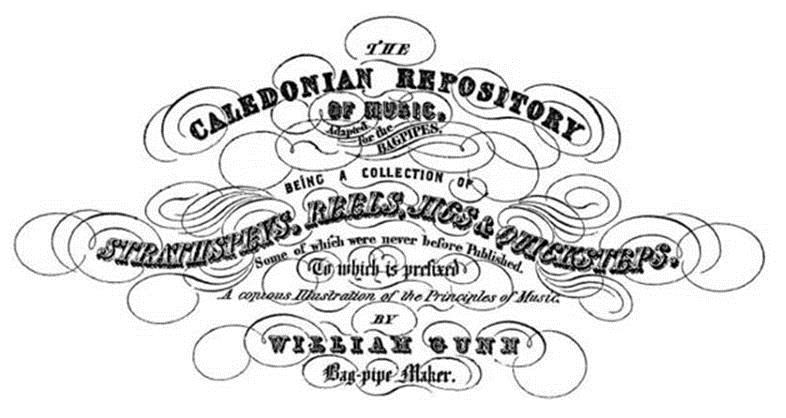
PRINCIPLES OF MUSIC
Music consists
of a variety of pleasing sounds, produces by the Voice or by an
Instrument, which sounds, when combined and arranged, produce Melody,
and Harmony; the former being the result of a succession of simple
sounds, and the latter, of the union of two or more musical sounds. In
Bag-pipe Music the Drones produce a fixed Harmony to the Melody, which
is illustrated hereafter.
I
Musical Sounds
are represented by characters called Notes, of which there are Seven,
expressed by the first seven letters of the Alphabet. The Notes are
written on and between five parallel lines. These lines and the spaces
between them, form the Stave, and include none notes or degrees of
sound. The lines and spaces are named after their number, counting
upwards from the bottom of the Stave. Lines supplementary to the Stave,
either above or below, are termed Ledger-lines, and are counted upwards
from above the stave, and downward from below it.
The Stave &c.

|
|
Thus
C – 1st Ledger-line below
D – Below the line
E
– 1st Line
F
– 1st Space
G
– 2nd Line
A
– 2nd Space
B
– 3rd Line
C
– 3rd Space
D
– 4th Line
E
– 4th Space
F
– 5th Line
G
– Above the line
A
– 1st Ledger-line above, &c. |
|
II
The Gamut or
Scale, inserted here,
consists of two Octaves, and extends to all the notes and degrees, used
in Vocal Music, and the letters by which they are named in the Treble or
G cleff. An Octave consists of any seven successive notes. The first
of which is the key note, and the whole seven, the scale of that note.
And as an eighth is in unison with the first or key note, and hence only
a repetition thereof, either in a higher or lower degree; all
supplementary notes, either above or below, are only repetitions of
these seven.
The Scale is
represented on perfect instruments such as an Organ, Piano &c. as
consisting of 12 successive sounds in the Octave, called semitones or
halftones, this is called the Chromatic Scale, in this case any of the
12 semitones may be assumed as a key note, but the Diatonic Scale is
that represented in writing, by seven notes, consisting of five full
tones and two semitones. From the disposition of these two semitones in
the Scale, arises the Major and Minor Moods in musical composition, and
all the Tunes must be either of the one, or the other. In the natural
scale of C, the semitones are placed betwixt E and F, and betwixt B and
C, and are indicated by a curve from the one note to the other, in the
scale given below.
The Gamut or
Diatonic Scale

The above figures
denote the 1st 2nd 3rd &c. degrees of
the respective scales to which they belong. It is also seen that in the
Major scale, the semitones are placed betwixt the 3rd and 4th
and 7th and 8th degrees, and in the Minor scale,
betwixt the 2nd and 3rd, and 5th and 6th
degrees, and as the same disposition of the semitones serves for both
Moods, every Major Mood has its relative Minor, the key note of the
Minor is the 3rd degree downward, or 6th upward
from the Major key note, as is seen in the example above.
III
In order to suit the
limited compass of the Voice and of certain Instruments, other keys than
C are assumed, but as in the assumed key, the semitones must stand
betwixt the same degrees of it, that they do in the natural key of C,
they are transposed from their natural positions in the key of C, to
their new positions by signatures, viz. a sharp (#) raises the note to
which it renders a semitone, and a flat (b) in the same manner
depresses the note to which it refers a semitone.
The Chanter of the
Bag-pipes is limited in all to nine notes, and to the scale of A Major,
from their natural positions in A Minor; as also the relative value of
the Major and Minor Moods. The scale is divided into three thirds, and
the number of semitones in each third is marked.
The original
positions of the semitones are marked under the notes as they occur in A
Minor, and the positions to which they are raised by the sharps to form
A Major, or the Bag-pipe Scale, are marked above the notes.
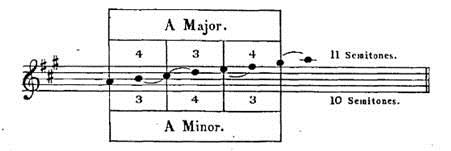
Other key notes than
A Major, are assumed on the Chanter but their Scales cannot be perfected
without the aid of artificial keys attached to the Instrument. The
small Drones are tuned in unison with the key note A, 1st
degree 2nd space, and the large Drone an Octave below that.
The Bag-pipe Scale is
fixed, and hence does not admit of transposition, therefore no
signatures, of sharps or flats, are made use of in Bag-pipe Music. The
following is a representation of the proper fingering of the Chanter to
produce the Scale of A Major.
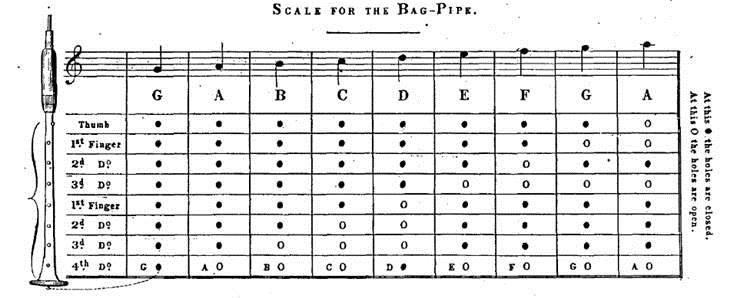
The Musical Note is
written six different ways, to indicate the duration of sound to be
given to each. The first and longest duration of time is represented by
the Semibreve ( ),
and the half of the time of the Semibreve is indicated by the Minum (q).
In Common Time, the duration of time represented by the Minum, is the
revolution of a Pendulum beating seconds. In duration of Sound, each
successive note is half of the former, as ),
and the half of the time of the Semibreve is indicated by the Minum (q).
In Common Time, the duration of time represented by the Minum, is the
revolution of a Pendulum beating seconds. In duration of Sound, each
successive note is half of the former, as
1 Semibreve is equal
to 2 Minums,
or to - - - - - 4 Crochets,
or to - - - - - 8 Quavers,
or to - - - - 16 Semiquavers,
or to - - - - 32 Demisemiquavers.
These Notes and their
Names are

A Dot placed after
any of these notes, makes it a half longer. The stems may be turned up
or down at pleasure, depending on their position on the Stave, as under,

Those notes having
hooks to the stems, may be grouped together in the following manner.

Each Musical Note has
its Rest, but rests are not used in Bag-pipe Music.
A Bar is a line drawn
across the stave. Singe Bars divide the music into equal portions and
time, and in beating time, the foot should always go down at the
beginning of every bar. Double Bars are placed in the middle, or at the
end of a Tune, to show that a part, or the whole is finished.
To Dots at the double
bar, signify, that the music on the dotted side of the bar is to be
repeated.
Single and Double Bars, with and without Dots.

The quantity of notes
in a bar are termed a Bar of Music, and every bar must be of the same
quantity or value throughout the same piece; but a bar of music is
different in different pieces, according to the Mood or Measure. There
are two measures, namely, Common, Time, and Triple Time, both of which
are subdivided into Simple and Compound. The value of music in the bar
is denoted by Characters or Figures placed at the beginning of the
piece. When figures are used for this purpose, the denominator denotes
the value of the notes, compared with the Semibreve, and the numerator,
the number of these notes to compose the bar, or of smaller notes, being
their equivalents in value, - that is, 3/2 signifies that the bar
contains 3 halves or 3 Minums, 3/4 signifies 3 fourths or 3 Crochets,
3/8 signifies 3 Quavers, &c.
Simple Common Time Compound Common Time

Simple Triple Time Compound Triple Time

A Hold or Pause, is a
semicircle and a dot place over or under a note,  and
denotes that it is to be held longer than its real time. A Slur is a
curve drown over or under two or more notes differing in pitch, and
indicates that they are to be performed in a smooth connected style. A
slur with the figure 3 requires that the three notes be played in the
time of two of these notes, and if the slur be six notes, with the
figure six, they must be played in the time of four notes. and
denotes that it is to be held longer than its real time. A Slur is a
curve drown over or under two or more notes differing in pitch, and
indicates that they are to be performed in a smooth connected style. A
slur with the figure 3 requires that the three notes be played in the
time of two of these notes, and if the slur be six notes, with the
figure six, they must be played in the time of four notes.

First and Second Time
denotes, that you are to play the first time to the double bar, and in
playing over the second time that you omit the part marked 1st
time, and proceed to that marked 2nd time.

The Appoggiatura, or Grace Note.
The demisemiquaver
 is
very much made use of in Bag-pipe music as a grace note, and falls into
the principal note immediately following. They are generally performed
by the forefinger of both upper and lower hands and also by the third
finger of the upper hand. is
very much made use of in Bag-pipe music as a grace note, and falls into
the principal note immediately following. They are generally performed
by the forefinger of both upper and lower hands and also by the third
finger of the upper hand.
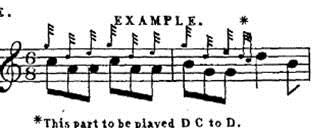
In beginning to learn
to play the Bag-pipe, the learner should commence, first, with the
practicing chanter, by placing the first three fingers of the left hand
on the chanter, and the thumb on the hole behind, then place the four
fingers of the right hand on the other holes of the chanter, observing
that the fingers must be so far across the chanter as to bring the
middle joints of the second and third fingers on the holes. After
placing the hands in this position, the learner commences with the
Gamut, and then the exercises, and after learning to play a few tunes
correctly and with tolerable ease, he may then commence to keep wind to
the Pipe. First to place the first two fingers and thumb of the left
hand on the chanter, and taking the stock of the big drone in the right
hand, then blow into the bag, and, when full, shove it under the left
arm. The arm must be kept firm on the bag, and when drawing breath
press the arm gently on the bag, so as to keep the chanter and drones
going, the same as wen blowing into the bag; and so on alternately
blowing and pressing with the arm, and by a little practice he will soon
be able to play the Pipe.
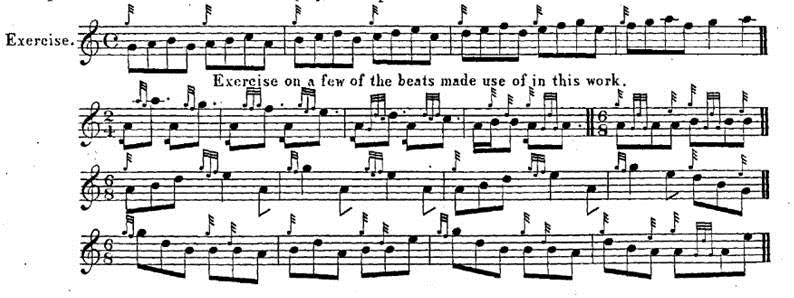
|